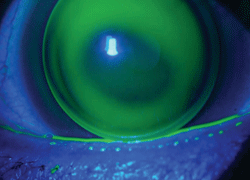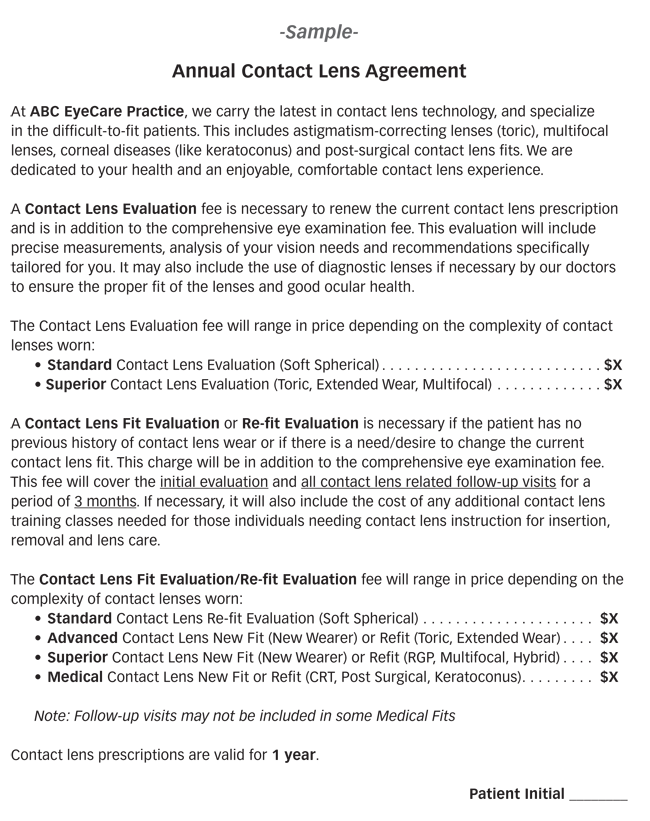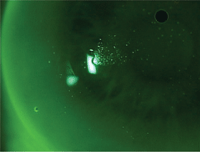In the face of health care reform, contact lenses are vitally important to the optometric business model. Advanced contact lens materials, designs and solution systems have improved our ability to provide a comfortable contact lens wearing experience—but being able to properly code and be reimbursed for your time, expertise and materials is critical to success.

Fitting a patient with keratoconus can be tricky. (This lens will need to be altered to vault the cone area better.) Coding and billing for such a lens fit can be even trickier.
You may be missing a key opportunity if you neglect to promote your treatment protocol with contact lens wearers. Developing a strong foundation will, in turn, create a strong business revenue center.
Here are seven ways to make sure you do it right:
1. Orchestrate the Encounter
Analyze your interaction with your patients from their perspective and break it down:
- Who is going to start the conversation about contact lenses? Is it going to be the doctor, a staff member or the patient who initiates this process? My recommendation is that the doctor or staff members should lead a proactive discussion about the contact lens options. Let the patient know that she or he is an excellent candidate for contact lens wear. If it is your patient who initiates the discussion every time, you’re likely missing some opportunities.
- Who is going to present the fees? Again, once you’ve determined that a patient is interested in wearing contact lenses, a conversation about the costs should be immediate and should take place right in the exam room. Whether it is the doctor or a staff member who will discuss the process and go over the associated fees, this step needs to be done before the patient gets to the checkout desk.
2. Differentiate the Coding for Elective Contact Lens Wearers
Contact lens wearers do require more time and follow-up; that additional service is worth something. When setting the various levels of fees, it is important to consider whether it’s an established contact lens patient, a first-time multifocal wearer or a newly-diagnosed keratoconic patient. The fee will most likely have a range from the least (straightforward evaluation) to the highest (very challenging).
Use CPT 92310, which is defined as: “Prescription of optical and physical characteristics of and fitting of contact lens, with medical supervision of adaptation; corneal lens, both eyes, except for aphakia.”1
Note that CPT 92310 is for both eyes. If you’re prescribing and fitting for only one eye, add modifier -52 (for “reduced services”). In addition, because “elective contact lenses” may be a covered benefit by your refractive carriers, it’s vital that you understand what your obligations are under your contract.
3. Discuss and Disclose Fees with a Contact Lens Agreement Form
Assign your staff to help with some of the contact lens-related duties. For example, technicians can discuss the fitting process, expected follow-up visits and appropriate fees depending on the patient’s prescription needs.
Fees can be a hurdle for some patients, and some are surprised that there’s an extra cost for this service. Our technicians can handle many of these inquiries and can head off any uncomfortable situations to avoid such surprises.
To that end, consider developing a contact lens agreement form to discuss the fees and any associated follow-up appointments. (See “Sample Annual Contact Lens Agreement.")

4. Use the Unique Codes for Aphakic Fits
Aphakic contact lens fits are often reimbursed through the patient’s medical carrier. Keep in mind that this service is separate from any evaluation and management services or general ophthalmological services, which should be reported using the appropriate code (99000 or 92000 series) if that level of service was performed and met.
The codes for aphakic contact lens fits are either 92311 (for one eye) or 92312 (for both eyes). CPT defines these as:1
- 92311: “Prescription of optical and physical characteristics of and fitting of contact lens, with medical supervision of adaptation; corneal lens for aphakia, one eye.”
- 92312: “Prescription of optical and physical characteristics of and fitting of contact lens, with medical supervision of adaptation; corneal lens for aphakia, both eyes.”
Make sure to bill the appropriate material code (V code) that most closely matches the material and design of the lenses:
- V2513: Gas-permeable lens, extended wear, per lens.
- V2530: Hybrid contact lens.
- V2531: Gas-permeable scleral lens, per lens.
- V2599: Contact lens, other type, per lens.
5. Use the Unique Codes for Therapeutic Lens Fits
Since January 1, 2012, there has been a change in the CPT codes for therapeutic contact lenses. CPT Code 92070 was retired and replaced with the following codes:
- 92071: Fitting of contact lens for treatment of ocular surface disease.
- 92072: Fitting of contact lens for management of keratoconus, initial fitting only.
Unfortunately, not every medical insurance carrier will pay for these codes. So, contact the patient’s medical insurer in advance to determine what, if anything, they will pay for before proceeding. It’s important that the patient knows the total amount that they will owe before you provide the services, rather than after.
6. Don’t Neglect Ocular Surface Disease
Ocular surface disease is a very familiar situation that many eye care professionals encounter. Providing medical eye care to these patients can be a powerful addition to an optometric practice, which includes bandage contact lenses (rigid or soft). Bandage soft contact lenses can help relieve pain and promote healing in patients with trauma to the cornea, and larger diameter scleral lenses are often prescribed for other ocular surface conditions.
Corneal abrasion is one of the most common uses for these lenses in primary care practices. In the presence of a corneal abrasion, bandage soft contact lenses shield the corneal surface from the constant mechanical irritation of the blinking eyelids. Once the lens is placed on the eye, patients feel considerable comfort almost immediately and, by controlling the pain, they can return to normal function.2,3

A large-diameter GP lens vaults the cornea of a post-LASIK patient. Do you think this lens is “medically necessary”? Of course—but not every insurance plan will agree.
For the billing and coding, you would:
- Bill the office visit at the appropriate level (92xxx or 99xxx), if performed and recorded.
- Bill for the fitting of the contact lens for the treatment of the ocular surface disease (CPT 92071). Be sure to indicate the specific eye (RT or LT) because this code is unilateral in nature.
- Bill a material fee as well. Choose either CPT 99070 (supplies and materials, except spectacles, provided by the physician over and above those usually included with the office visit or other services rendered) or the appropriate V code, most likely V2523 (contact lens, hydrophilic, extended wear, per lens).
Note that many providers are typically using a disposable contact lens for this purpose and it is inappropriate to bill for a non-revenue lens (trial or diagnostic lens) if you have provided that.
7. Take Care with Specialty Services, like Keratoconus
Many patients require specialty contact lenses for either vision or comfort reasons. Specialty lenses are valued for their ability to mask corneal irregularities associated with various diseases, including keratoconus. If you’re working with a vision plan:
- The benefit for “medically necessary” contact lenses is usually in addition to, and not a substitute for, eyeglasses. Check to see if you can obtain spectacles for your patient as well.
- Complete a pre-authorization form to determine the patient’s eligibility ahead of time.
For a keratoconus contact lens fit submitted to the medical carrier:
- Bill the office visit at the appropriate level (92xxx or 99xxx), if performed and recorded.
- Bill the fitting of the contact lens for the treatment of keratoconus (CPT 92072—a bilateral code).
- Bill a material fee with the most appropriate V code (most likely V2530, V2531 or V2599).
92072 describes the act of fitting the keratoconus lenses for both eyes, establishing parameters and ordering the lenses. It does not include the follow-up visits, which should be charged separately using the most appropriate office visit code (99xxx or 92xxx).
It is a travesty that some carriers do not perceive this service (92072) as a covered medical service and will not reimburse for it. These patients often desire and need special medical attention and too often the bill often falls back on the patient; be sure to use an Advance Beneficiary Notice of Noncoverage (ABN) appropriately and within the guidelines as provided by the carrier.
Your contact lens business is vitally important to the success of your optometric practice. These steps will improve your in-office protocols and the ability to be reimbursed appropriately for your time and expertise.
Dr. Miller is in a partnership practice in Powell, Ohio. He is an extern preceptor for fourth-year students at The Ohio State University College of Optometry, and he is one of the doctors (along with Chuck Brownlow, OD, and Walter Whitley, OD, MBA) behind AOA’s [email protected].
1. CPT definitions. AOACodingToday. Available at:
www.aoacodingtoday.com. Accessed March 4, 2012.
2. Buglisi JA, Knoop KJ, Levsky ME, Euwema M. Experience with bandage contact lenses for the treatment of corneal abrasions in a combat environment. Mil Med. 2007 Apr;172(4):411-3.
3. Brujic M, Miller J. Alternative uses for contact lenses. Rev Cornea Contact Lenses. 2009 Mar: 146(2):12-3.

